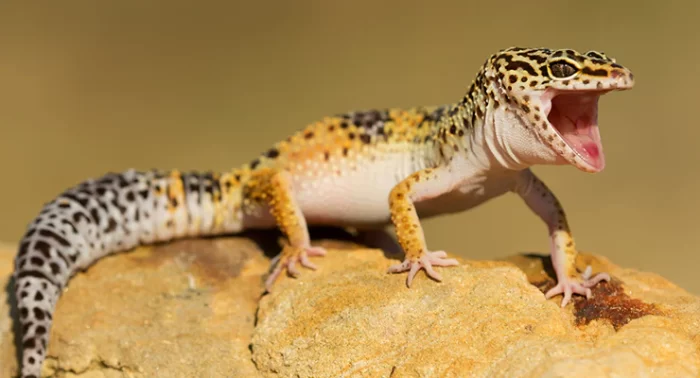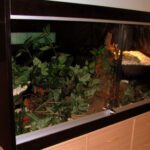Leopard geckos make great pets for beginner and experienced reptile owners alike. These docile, hardy lizards are relatively easy to care for as long as their habitat needs are met. Providing an appropriate enclosure and environment is key to keeping your leopard gecko healthy and happy. In this article we talk about Leopard Gecko Habitats Effective Disinfection Techniques.
Table of Contents
Enclosure Size
Leopard geckos are terrestrial lizards, meaning they live on the ground. They are active explorers and need enough room to move around comfortably. The recommended minimum enclosure size for one adult leopard gecko is a 20-gallon long tank, which provides adequate floor space. If housing multiple geckos, aim for a 10-gallon tank per gecko. Make sure the enclosure is escape-proof with a secure screen top.
Substrate
The substrate, or tank lining, is a critical aspect of habitat design. Loose particulate substrates like sand or crushed walnut shells can cause impaction if accidentally ingested when your gecko catches its prey, so these should be avoided. Recommended solid substrate options include:
- Reptile carpet: Easy to clean and replace. Ensure there are no loose threads.
- Paper towels: Economical but requires frequent replacement.
- Slate or ceramic tiles: Durable and mimic natural surfaces. Can be cold so provide a heat gradient. -Shelf liner: Textured options allow traction without loose particles.
Hideouts
In the wild, leopard geckos take shelter in rock crevices and burrows. Recreate this in captivity by providing a minimum of three hideouts:
- Warm humid hide on the hot side to aid shedding. This can be a small plastic humid hide or simple box with a hole cut out of it and damp substrate or moss added inside.
- Cool dry hide on the cool end of the tank to allow temperature regulation
- Moist hide box in between to provide additional security and choice.
Having multiple hides allows your gecko to thermoregulate and feel secure.
Heating & Lighting
Since leopard geckos are cold-blooded, providing the proper temperature range is essential for digestion and immune function. Create a thermal gradient in the tank with three distinct zones:
Warm end: 88-92°F. Place an under tank heating pad here to create a hot spot.
Middle: 80-83°F ambient temperature maintained by a heat lamp above the mesh lid
Cool end: 75-80°F without supplemental heating for your gecko to cool off if needed.
The temperature can drop to 70°F at night since this mimics their natural habitat. Thermometers at each end allow close monitoring to maintain the ideal thermal gradient.
Leopard geckos are crepuscular, meaning they are most active at dawn and dusk. Provide 10-12 hours per day of UVA/UVB light on a cycle timer to create this day/night rhythm. Ensure the wattage matches tank size.
Accessories & Enrichment
Customizable décor and accessories make the habitat interesting and engaging. Consider adding:
- Climbable branches and cork logs
- Plants and foliage – live or artificial
- Rock slates stacked to create nooks and platforms
- A small shallow pool – helps raise humidity
Also rotate novel smells and textures to provide sensory stimulation. Just make sure décor does not block heating or lighting.
Cleaning & Disinfection Protocol
While leopard geckos themselves are fairly tidy, their enclosures do require regular cleaning and disinfection to prevent disease. Spot clean waste daily and full cleans every 1-2 weeks.
The general cleaning process is:
- Remove gecko to a secure temporary container
- Remove all décor, hideouts and substrate into sink or bin
- Thoroughly rinse enclosure walls, floors, lid with hot water to remove stuck on debris
- Clean décor and hideouts with hot soapy water and scrub brush
- Disinfect ALL surfaces – inside enclosure, fixtures, décor. Use a veterinarian recommended reptile-safe disinfectant and closely follow label dilution and contact time instructions for efficacy against pathogens. Common disinfectants include:
- Chlorhexidine based cleaners
- Select bleach products at proper dilution
- Quaternary ammonium compounds
- Potentiated iodines
- Rinse all surfaces thoroughly and allow to dry fully before reassembling enclosure
- Replace substrate and décor items
- Wash hands before reintroducing your leopard gecko back into habitat
By using the proper cleaning technique and reptile-safe disinfectants, you can help maintain a healthy habitat free of dangerous microbes like Salmonella and other bacteria.
Quarantine New Geckos
When bringing home a new leopard gecko from a pet store or breeder, it is wise to quarantine the new pet separately for a minimum of 90 days. House the gecko in a sterile tank with paper towels, separate décor items, feed/water bowls not used for other pets. This prevents introducing diseases to your existing gecko. Monitor the quarantined gecko closely for signs of illness and schedule a wellness exam with an exotic vet during this period. Only after 3 months of a confirmed clean bill of health should you introduce the new gecko.
Proper habitat design, temperatures, sanitation and quarantine together help provide the ideal environment for a healthy, thriving leopard gecko. Carefully simulating their natural habitat allows them to display their delightful behaviors and live their best lives as captivating pets. With modest investment and appropriate care, leopard geckos can enjoy 10+ years of life with their owners. I sincerely hope you find this “Leopard Gecko Habitats Effective Disinfection Techniques” article helpful.




